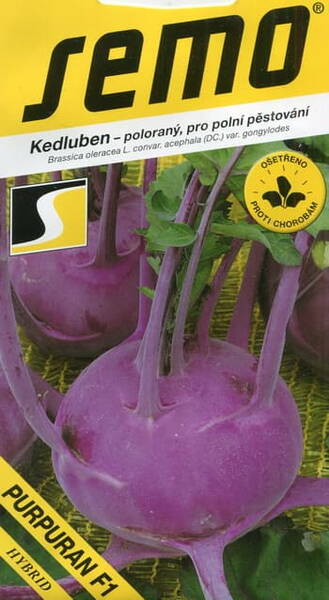Ex Tax: 1.35€
Nutrient champion among cabbages.
The variety is early maturing, the period from germination to economic suitability is 72-88 days. The stalk is round-flat, weighing 160 g. The pulp is tender, juicy with a high content of sugar and vitamins. Heat and drought resistant. Differs in amicable return of a harvest. The taste qualities are excellent.
Due to the high precocity, kohlrabi can be grown in open ground throughout the summer in seedlings and seedlings, obtaining up to 4-5 crops with stepped crops.
In Estonia, seedlings are planted in late April - early May to obtain an early harvest, and in the second decade of July to obtain a harvest in autumn. Sowing depth 1-2 cm. Planting pattern 12-15 x 30-35 cm.
In kohlrabi, the food organ - the stem crop - is most suitable for food with a diameter of 6-8 cm.
Sowing time: April.
Planting seedlings: May.
harvesting: June, July.
Planting methods: open ground, seedlings.
Distance between plants: 15 cm.
Distance between rows: 30 cm.
Weight per 1000 seeds = 3,4-4,8 g.
Number of seeds in 1,0 g = 260.
Kohlrabi grows seedlings and seedless way.
The cultivation technique is similar to that of white cabbage. Unlike other types of cabbage, seedlings are planted shallowly, sprinkling only the root system with earth (with deep planting, elongated stems are obtained). Watering and top dressing are carried out at the beginning of the formation of the stem crop.
Kohlrabi is harvested when the stems reach 8-12 cm in diameter (when overripe, they become coarse and fibrous).
Store at a temperature of 0 ° C, with a humidity of 95% for 1.5-2 months. Kohlrabi stalks are juicy and firm, from light green to dark purple in colour (depending on the variety).
The nutritional and dietary value and pleasant taste of the plant are due to the high sugar content, a large number of mineral salts - potassium, calcium, magnesium and phosphorus, as well as vitamins (niacin, riboflavin, thiamine). According to the content of vitamin C, kohlrabi is not inferior to lemons and oranges.
The use of kohlrabi in food has a beneficial effect on the nervous system, metabolism and the functioning of the digestive organs, especially the liver and gallbladder.












